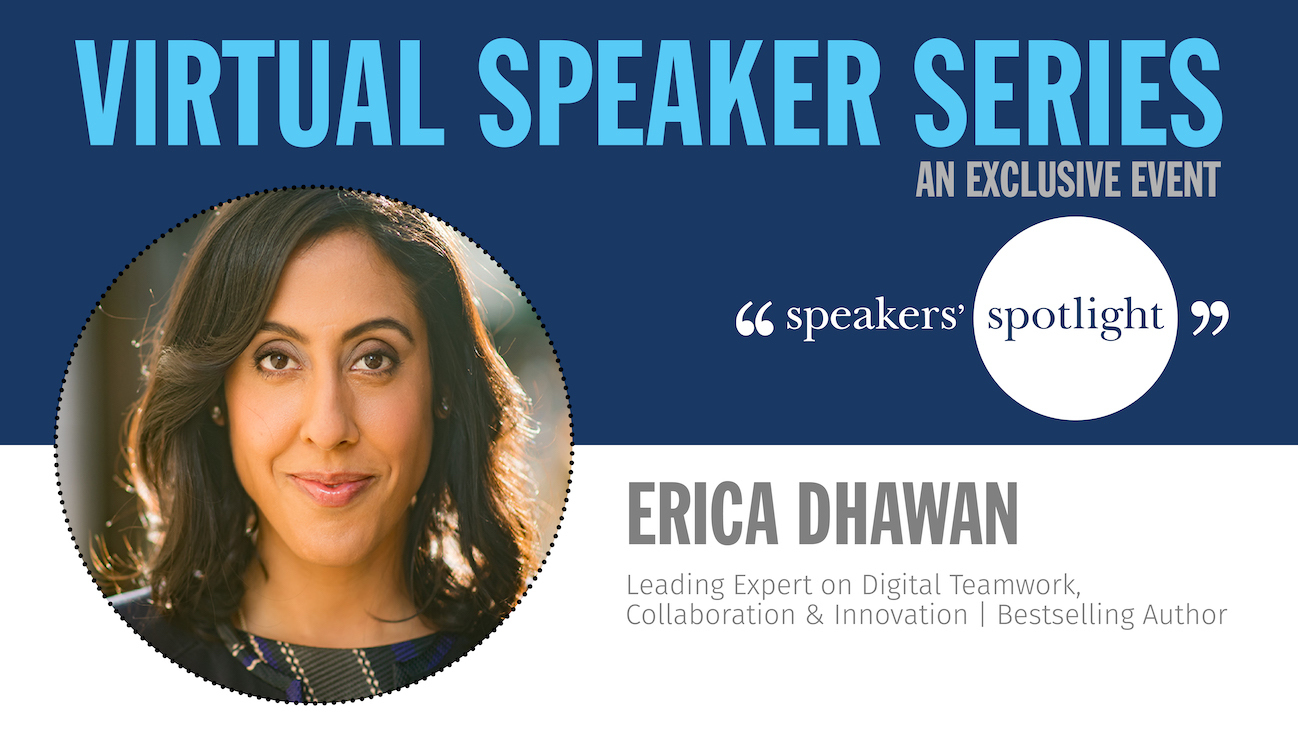Joining us for this week’s Virtual Speaker Series session, digital teamwork and collaboration expert Erica Dhawan shared timely guidance on how we can more clearly and effectively communicate digitally—whether over video, text, or email. Offering tips and strategies from her upcoming book, Digital Body Language, she outlined common frustrations and easy solutions that are applicable whether we are working remotely or in any kind of modern office environment.
To begin with, Erica talked about where we stand with digital communication right now. She offered commonplace scenarios as examples of how some bad habits or less-than-careful communication can lead to serious stress and anxiety. Erica talked about how we’ve replaced quick check-in conversations and discussions with back and forth messaging that can sometimes stretch over hours while still lacking clarity. This is why we need better digital collaboration skills.
This is where the idea of digital body language and understanding the role it plays is so important in fostering a healthier workplace communication environment. Erica has graciously provided a link to a digital toolkit that should be helpful as a reference while trying to put her advice into action moving forward. That advice centers around the cues and signals we send through our communications, whether we mean to or not, and the general best practices that show respect for our coworkers and fellow team members. These signals can relate to anything from when we set meetings, to how we use punctuation and emojis in messages, to how clear we are with deadlines and expectations.
Erica put forward a set of key principals to improve our quality of digital communication:
Brevity Creates Confusion
“Communicate Your Mind” Mindset
Hold Your Horses
Assume the Best Intent
Find Your Voice
While some of these are straightforward, some deserve further explanation. For example, “communicate your mind” mindset refers to an obvious aspect of body language that’s lacking in digital communication and that is emotional feedback. Erica said small things like a nod or a smile when discussing a project or accepting some completed work instantly makes it clear to the other party how we’re feeling. In text form, we need to be more explicit and let the person know how we’re feeling. Let’s say you’ve asked for a spreadsheet summary of data from a co-worker. When you receive it, you could simply write back “thanks” but by spending those extra few seconds to write “Thanks. This is exactly what I needed and will be very helpful. Good work!” A few moments spent spelling out the emotional feedback that would come naturally from working together in person can go a long way.
Finding your voice to best communicate with colleagues, management, and clients alike can be a tricky proposition but is worth spending time considering. Erica acknowledged that it’s a serious undertaking to figure out how we can comfortably communicate with people across such a diverse array of backgrounds, generations, and levels of experience. But, she said, this is why we should be more conscious than ever in terms of how we communicate, while at the same time striving to be genuine and find a way to convey our messages both clearly and comfortably. Simplicity, clarity, and consistency are all qualities we should focus on in our communications.
Finally, as she was wrapping up her presentation, Erica presented her “Four Laws of Digital Body Language” to always keep in mind moving forward—especially among managers and leaders. These are:
Value Visibly
Behaviour like chronic cancellations and last-minute rescheduling can make it seem like you’re careless with other people’s time and energy. Be mindful of the clock, acknowledge individual differences among employees, and practice radical recognition for all the hard work that people do.
Communicate Carefully
Think before you type and always try your best to deliver messages with maniacal clarity. Less haste equals more speed/efficiency, preventing time wasted on miscommunications and misunderstandings while also avoiding anxiety-inducing mix-ups.
Collaborate Confidently
Say what you’ll do and follow through. Make sure people are kept informed, prioritize responsibilities and stay on track. Always pay attention to details as much as possible.
Trust Totally
Give others the benefit of the doubt. Try to create virtual water cooler moments for social interaction and brainstorming. And be willing to show vulnerability in front of others. Everyone makes mistakes and bad days. It’s ok to share frustrations and commiserate.
At the end of her presentation, Erica took some questions from the audience. One thing that she wanted to highlight is that in her work she’s finding there is a lot of discussion happening in organizations as they try to decide what their work environment will look like moving forward, as they try to balance what leadership wants, what employees want, and what’s best for their clients and customers. Nevertheless, a thoughtful approach to digital collaboration and communication will continue to be useful whether we are working from home, in the office, or between the two.
Erica Dhawan says we all have the power to drive innovation, but first we need to get past the roadblocks we create for ourselves: endless meetings, cross-team dysfunction, resource-wasting duplication, and a lack of real, meaningful inclusion. Drawing on her original research, frontline experience, and proven practical methods, Erica helps teams and organizations tap into their Connectional Intelligence and take their collaboration to the next level in an era of digital-first workplaces.
Speakers’ Spotlight has been offering virtual presentations since 2009. We work with a range of speakers who are comfortable with presenting virtually on a variety of topics. If interested, contact us for more information.




